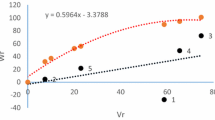Abstract
Complete F1 and F2 diallel crosses were used to investigate the inheritance of yield among eight Ugandan bread wheat lines grown in two low-yielding environments; one marginal because of the high incidence of yellow rust normally experienced there, the other a low-rust site. In the marginal, high-rust environment, mainly additive genetic variation was present, though in one season, when disease incidence was unusually low, non-additive variation due to dominance was also detected. Although yield was significantly higher at the low-rust site, no clear pattern of inheritance was apparent there. The results indicated that the low rust site was an intermediate environment, just below the crossover point of a crossover genotype-environment interaction. The implications of these results for wheat breeding in low-yielding and marginal environments in Uganda and elsewhere are discussed.
Similar content being viewed by others
References
Allard, R.W. & A.D. Bradshaw, 1964. Implications of genotypeenvironmental interactions in applied plant breeding. Crop Sci 4: 503–508.
Baker, R.J., 1988. Tests for crossover genotype-environmental interactions. Can J Plant Sci 68: 405–410.
Baker, R.J., 1990. Crossover genotype-environmental interaction in spring wheat. In: M.S. Kang (Ed.) Genotype-by-environment interaction and plant breeding, pp. 42–51. Louisiana State University, Baton Rouge, Louisiana.
Borgi, B. & M. Perenzin, 1994. Diallel analysis to predict heterosis and combining ability for grain yield, yield components and bread-making quality in bread wheat (T. aestivum). Theor Appl Genet 89: 975–981.
Braun, H-J., S. Rajaram & M. van Ginkel, 1996. CIMMYT's aproach to breeding for wide adaptation. Euphytica 92: 175–183.
Busch, R.H., K.A. Lucken & R.C. Frohberg, 1971. F1 hybrids versus random F1 line performance and estimates of genetic effects in spring wheat. Crop Sci 11: 357–361.
Ceccarelli, S., 1989. Wide adaptation: How wide? Euphytica 40: 197–205.
Ceccarelli, S., 1996. Adaptation to low-high input cultivation. Euphytica 92: 203–214.
Cooper, M. & I.H. DeLacy, 1994. Relationships among analytical methods used to study genotypic variation and genotype-byenvironment interaction in plant breeding multi-environment experiments. Theor Appl Genet 88: 561–572.
Gravois, K.A., K.A.K. Moldenhauer & P.C. Rohman, 1990. Genotype-by-environment interaction for rice yield and identi-fication of stable, high-yielding genotypes. In: M.S. Kang (Ed) Genotype-by-environment interaction and plant breeding, pp. 181–188. Louisiana State University, Baton Rouge, Louisiana.
Griffing, B., 1956. Concept of general and specific combining ability in relation to diallel crossing systems. Aust J Biol Sci 9: 463–493.
Hayman, B.I., 1954. The analysis of variance of diallel tables. Biometrics 10: 235–244.
Hill, J., H.C. Becker & P.M.A. Tigerstedt, 1998. Quantitative and ecological aspects of plant breeding. Chapman & Hall, London, 275 pp.
Jinks, J.L., 1954. The analysis of continuous variation in a diallel cross of Nicotiana rustica varieties. Genetics 39: 767–788.
Jinks, J.L. & V. Connolly, 1973. Selection for specific and general response to environmental differences. Heredity 30: 33–40.
Jinks, J.L., J.M. Perkins & H.S. Pooni, 1973. The incidence of epistasis in normal and extreme environments. Heredity 31: 263–269.
Mather, K., 1973. Genetical structure of populations. Chapman & Hall, London, 197 pp.
Mather, K. & J.L. Jinks, 1982. Biometrical genetics, 3rd edn. Chapman & Hall, London, 382 pp.
Menon, U. & S.N. Sharma, 1994. Combining ability analysis for yield and its components in bread wheat over environments. Wheat Information Service 79: 18–23.
Rajaram, S., H-J. Braun & M. van Ginkel, 1996. CIMMYT's approach to breed for drought tolerance. Euphytica 92: 147–153.
Singh, M. & S. Ceccarelli, 1995. Estimation of heritability using varietal trials data from incomplete blocks. Theor Appl Genet 90: 142–145.
Stubbs, R.W., 1985. Stripe rust. In: A.P. Roelfs & W.R. Bushnell (Eds) The Cereal Rusts II, pp. 61–101. Academic Press, London.
Virk, D.S. & P.S. Virk, 1986. The assessment of genetic variation for normal, self, and backcross families of a triple test cross of pure-breeding lines in wheat. J Agric Sci Camb 106: 1–6.
Wagoire, W.W., 1997. Yellow rust resistance of wheat cultivars in Uganda. Ph D Thesis, Department of Agricultural Sciences, The Royal Veterinary and Agricultural University, Copenhagen, Denmark, 111 pp.
Wearden, S., 1964. Alternative analyses of the diallel cross. Heredity 19: 669–680.
Whitehouse, R.N.H., J.B. Thompson & M.A.M. do Valle Ribeiro, 1958. Studies on the breeding of self-pollinating cereals. 2. The use of a diallel cross analysis in yield prediction. Euphytica 7: 147–169.
Author information
Authors and Affiliations
Rights and permissions
About this article
Cite this article
Wagoire, W., Hill, J., Stølen, O. et al. Impact of genotype-environment interactions on the inheritance of wheat yield in low-yielding environments. Euphytica 105, 17–23 (1999). https://doi.org/10.1023/A:1003444509455
Issue Date:
DOI: https://doi.org/10.1023/A:1003444509455




